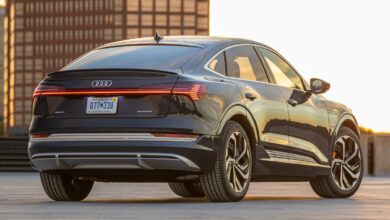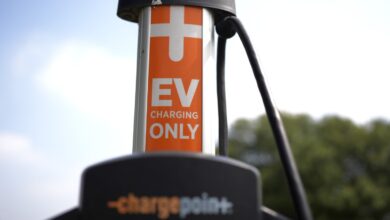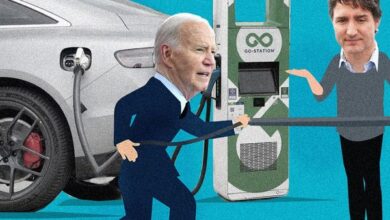Which EVs (and Buyers) Qualify for the Used Tax Credit?

2020 Nissan Leaf | Manufacturer image
It’s a great time to shop for a used electric vehicle, especially as the federal government will spot you up to $4,000 for a down payment. Virtually every make and model of used EV is eligible — subject to a $25,000 price limit and other federal sales criteria. And if you aren’t ready to flip the switch on a full EV, most plug-in hybrids also qualify for that cash.
Related: Which New Electric Cars Are Still Eligible for the $7,500 Federal Tax Credit?
The new change for the program in 2024 is that buyers of used EVs and PHEVs from a dealer can get the tax credit at the time of purchase rather than waiting to claim it on their tax returns.
Which Used EVs Can I Get for $25,000?
Part of why it’s a great time to buy a used EV (and not so much to sell one) is there are more to choose from within the $25,000 price limit. Values for used EVs have been hammered by price cuts on new EVs by Tesla and some other brands. While the average prices for all used vehicles were down by 6.3% year over year as of April 2024, average prices for used EVs dropped by 20.2%, according to Cars.com data.
At the time of this writing, there are 3,760 EVs listed on Cars.com under $25K, along with 30 of the harder-to-find PHEVs. Among them are one-owner Chevrolet Bolt EVs and EUVs and Nissan Leaf hatchbacks that meet the age and price caps, as well as Tesla Model 3 and Model S sedans, Hyundai Kona EVs and Jaguar I-Pace luxury SUVs. Other eligible examples listed for sale on Cars.com include BMW i3s (with and without the range-extender motor), Volkswagen ID.4s, Mustang Mach Es, Hyundai Ioniq EVs and Kia Niro EVs.
How Vehicles Qualify
The Used Clean Vehicle Credit is a government tax program, so of course there are more rules, but they are a whole lot simpler than the complex assembly and sourcing restrictions for the up-to-$7,500 credit for a new EV or PHEV. While the new-car rules have cut the list of new vehicles that qualify for 2024, the used-car credit simply extends to EVs and PHEVs with a battery capacity of at least 7 kilowatt-hours (almost all of them), as long as the vehicle’s model year is two years earlier than the calendar year in which you buy it (currently 2022 models or older). You can see the federal list of plug-in (and also fuel cell) vehicles potentially eligible for the used-car credit here.
Beyond these battery-size and age requirements, there are a few other rules:
- The sales contract price must be $25,000 or less for the car and all fees, excluding tax and title. (A 2022 Mercedes EQS EV is theoretically eligible, but good luck finding one for $25K.)
- The credit is for 30% of the sale price, up to a maximum of $4,000 (you get $3,000 on a $10,000 car, for example).
- The vehicle cannot already have been transferred to a new owner since August 2022 (the date the used-vehicle program started).
- You must buy the EV or PHEV from a licensed dealer who has registered with the IRS. As of 2024, dealers must report the sale to the IRS and get confirmation that the car’s vehicle identification number is eligible — and give a copy of that paperwork to the buyer. The IRS recommends that buyers get this confirmation before completing the purchase.
Which Buyers Qualify
One of the goals of the used-vehicle credit for EVs and PHEVs is to help less affluent buyers get into an EV, so there are income limits for buyers to get the credit.
- The buyer’s modified adjusted gross income for either the current year or prior year is limited to $75,000 for individuals, $150,000 for a joint return and $112,000 for heads of households.
- The buyer must be an individual who is not claimed as a dependent on another person’s tax return and must be buying the vehicle for use, not resale.
- The buyer cannot have claimed a used-vehicle credit in the three years prior to the current purchase.
You can choose to take the credit at the time of purchase or later when you file your taxes, but there is an important bonus to claiming it when you buy: The IRS says you can keep the whole amount, even if your tax bill for the year turns out to be less money.
If you wait to claim it until you file your taxes, you can’t get more credit than your bill. If the vehicle qualifies for a $4,000 credit but you only owe $3,000 in federal taxes for the year, you’ll “lose” the excess $1,000 you didn’t need, and the IRS won’t send you a check. But note that if you claim the credit at purchase and your income turns out to be higher than the income limits, you’ll have to pay back the credit to the IRS.
2022 Chevrolet Bolt EV | Manufacturer photo
What About Used EV Battery Risk?
Buying any used vehicle entails some risk in exchange for a lower price, and getting a used EV means getting a used battery that could cost more than the car is worth to replace if it fails — but evidence so far is that the risk of complete battery failure is very low. In any case, failure likely would be covered by the battery warranty; most of these used EVs will have years left on the battery warranty that was at minimum a required eight years or 100,000 miles when new. Notably, many of the used Bolts on sale have barely used batteries with added years of warranty left because a manufacturing defect that led to a huge recall, battery replacement and an extended eight-year/100,000-mile warranty.
While failure is unlikely, the used EV’s battery will have lost some capacity (and range) from time and use. Some warranties offer a backstop that guarantees typically 70% to 75% of original capacity for the warranty period, but some don’t. Either way, it’s important to check the health of the battery before buying rather than focusing on odometer mileage. You can get a report of the vehicle’s battery health from websites like Recurrent, or you can check it yourself by charging it to 100% then comparing the range in the car’s instruments during a test drive to its original EPA rating. It may not be precise, but it is a good indicator.
The most important thing about the used EV’s range, however, is whether it meets your needs. Lower range might still be plenty for low-mileage city use or as a second vehicle if it also means a better price. You can read more details about EV battery life and health on Cars.com.
More From Cars.com:
Cars.com’s Editorial department is your source for automotive news and reviews. In line with Cars.com’s long-standing ethics policy, editors and reviewers don’t accept gifts or free trips from automakers. The Editorial department is independent of Cars.com’s advertising, sales and sponsored content departments.



